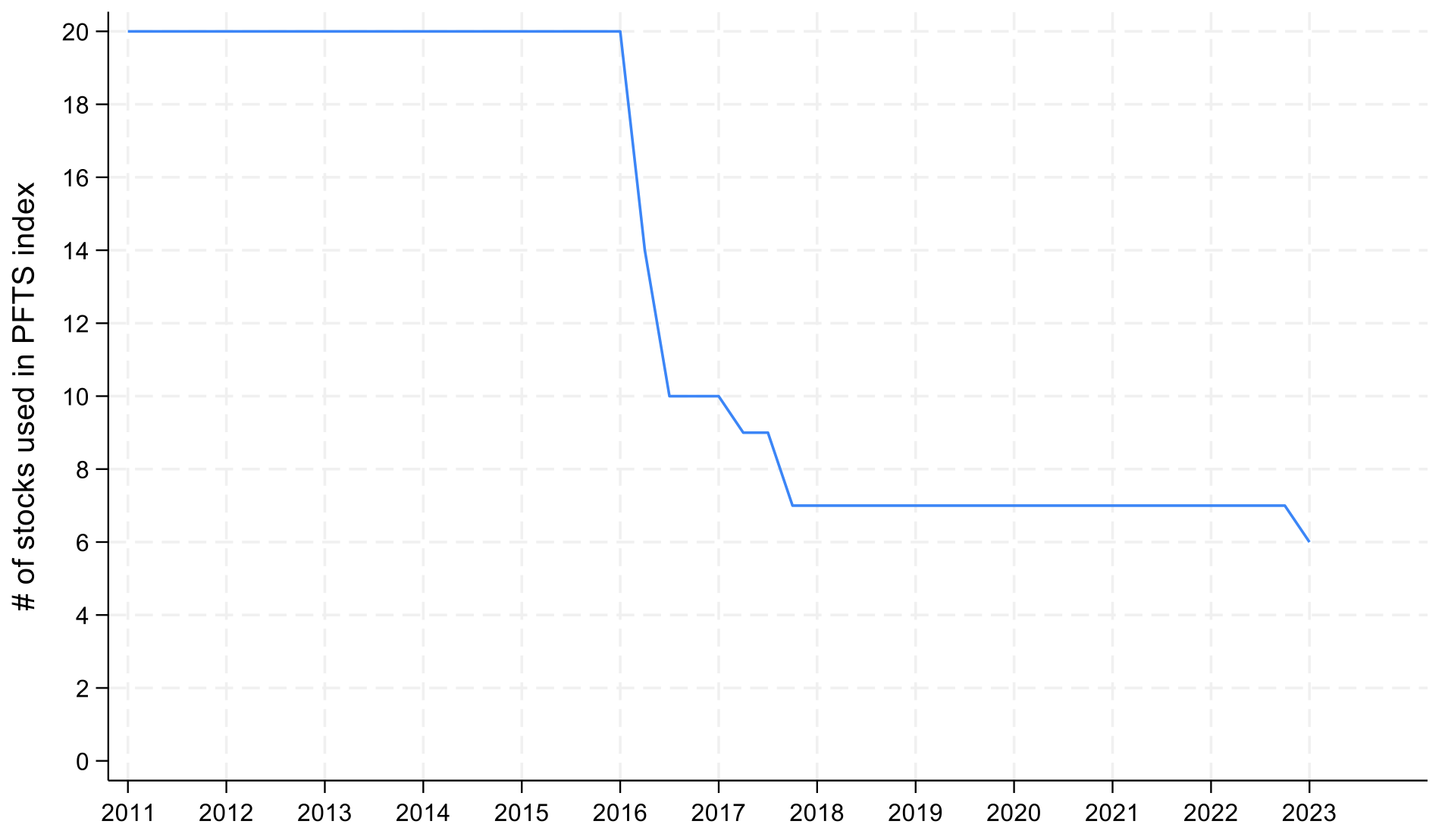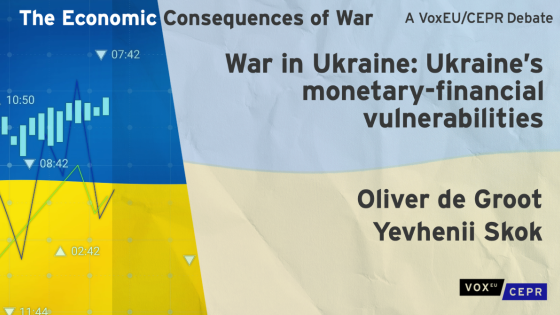When one thinks about post-war reconstruction of Ukraine as well as current challenges in Ukraine’s financial sector (e.g. Becker et al. 2022, 2023), it is important to understand the historical forces that shaped the capital market in Ukraine. In a recent CEPR report (Carletti et al. (2024), we provide a comparative perspective on the matter.
Given the difficult initial conditions, it would be unfair to compare Ukraine to countries with established, deep capital markets. As a result, some peers (e.g. Poland and other East European countries in the EU) are chosen because Ukraine aspires to emulate their success. Some peers (e.g. Bulgaria and Romania) are selected to get a better understanding of the costs of unfinished reform agendas (e.g. persistent corruption issues), while others (e.g. Slovakia) demonstrate how to catch up after a slow start. Some peers (Croatia, Georgia and Moldova) help to shed more light on the challenges faced by countries scarred by wars as well as issues related to living in the shadow of Russian aggression. We also use Germany as a frontier for what can be achieved in terms of development within the EU.
Similarly to other transition economies, Ukraine had little to no market infrastructure when the command economy collapsed in the Soviet bloc. Although Ukraine was more developed than some Eastern European counties, it had experienced a particularly difficult repression – including the Holodomor in the 1930s, which continues to weigh heavily on economic and political life even in the post-Soviet era (Yaremko 2023) – under Soviet rule. Much of policy work in the early 1990s focused on providing a legislative basis for creating financial markets. Laws were passed, regulators were created, government property was privatised, stock exchanges mushroomed. Formal indicators suggested that Ukraine was making good progress toward establishing a well-functioning financial sector, but this turned out to be only an appearance.
Indeed, even relative to its peers, Ukraine’s performance was lacklustre. Data collected by Beck et al. (2019) convey this message clearly. Market capitalisation as a percentage of GDP remained low up until the early 2000s (see Figure 1). For example, Poland, a popular benchmark for Ukraine, has capitalisation that was four times higher. The Czech Republic and Hungary also performed well, but these countries had earlier exposure to the market economy. More generally, the 1990s demonstrated that achieving a developed stock market is not guaranteed, and there is large variation in outcomes ranging from laggards like Bulgaria to successes like Poland.
Figure 1 Stock market capitalisation
Source: Beck et al. (2019)
The Orange Revolution in 2004 gave hope that Ukraine would re-energise its reform efforts and thus spur more development of capital markets. Consistent with that view, market capitalisation soared as more investors showed interest. But this was a broad trend for Eastern Europe rather than a Ukraine-specific development. Nearly all countries in the region experienced a boom until the global financial crisis of the late 2000s and early 2010s. The collapse of market capitalisation in East European countries was nearly universal, but Ukraine was hurt more. This was because the country not only had more exposure to fluctuations in commodity prices, but it also had weaker institutions and policymaking. Some markets (e.g. Poland) recovered, but many stayed depressed for years. These dynamics suggest that while some forces are common for East European countries (for example, the appetite of investors for taking risks in this part of the world), policies are also important. The dynamics of the number of listed companies per capita (see Figure 2) tells a similar story. Ukraine was firmly in the middle of the cross-county distribution with some elevation after the Orange Revolution, but the number of listed companies has been trending down since the global financial crisis.
Figure 2 Number of listed companies per capita
Source: Beck et al. (2019)
Russia’s annexation of Crimea and occupation of the Donbas in 2014 gave another shock to Ukraine’s financial system and broader economy. With a tsunami of non-performing loans, a spike in inflation, and massive economic contraction, the stock market became a ghost: market capitalisation was at 4% of GDP.
The Revolution of Dignity in 2013-14 accelerated reforms and the course of Ukraine towards integration with the EU. Yet despite significant progress in cleaning up the financial sector, fighting corruption, decentralising economic and political life, and many other areas, the stock market showed few signs of life, even with much of the necessary infrastructure already in place. A few statistics reveal the state of affairs.
At the end of 2021, Ukraine had two active organised exchanges. In 2021, three new firms were listed, bringing the total to 88 listed domestic firms, which is low by international standards. The volume of trade on these exchanges was modest (approximately UAH 451 billion in 2021) but 98% of the trade was in Ukraine’s government debt. Trades in shares accounted for UAH 0.5 billion. This is tiny not only relative to GDP (UAH 5.4 trillion) but also relative to the trading activity outside these exchanges (the volume of trade in shares outside exchange was UAH 21.3 billion in 2021). The trades in derivatives and shares issued by foreign firms were equally dismal. In other words, although the organised exchanges had some trading activity, these exchanges were effectively dead as stock markets or a capital market for privately issued bonds.
The history of listed stocks is informative too. Figure 3 shows that the number of stocks (i.e. Ukrainian blue chips) used for calculating the stock market index for the PFTS exchange has been shrinking. The Russian invasion in 2014 created highly adverse economic conditions for many Ukrainian companies but some companies were affected directly by the aggression. For example, Donbasenergo (DOEN), a utility in the Donbas, and Yenakiieve Iron and Steel Works (ENMZ), a steel mill in the Donbas owned by Metinvest, were under Russian occupation since 2014. While DOEN was partially under Ukrainian control and thus it was partially operational, ENMZ was fully under Russian control and it was shut down in 2022 as the factory did not have workers to operate it (the workers were mobilised into the Russian army). Thus, the Russian occupation of the Donbas in 2014 gave a huge blow to the market.
Figure 3 Number of stocks in PFTS index
The experience of Ukrnafta (UNAF), removed from the index in 2023Q1, is indicative too. The firm was owned by Ihor Kolomoiskyi and Gennadiy Bogolyubov (42% of the shares) and the government (50%+1 shares). Although the government had the majority, the management of the firm was installed by the Kolomoiskyi-Bogolyubov tandem. The scandals in the firm were perennial but more importantly, unlike other SOEs after 2014, Ukrnafta remained unreformed as the government could not establish control. In the end, the government nationalised the firm on the grounds of national security in November 2022 and the firm was subsequently delisted.
As of 2023Q1, only six companies are in the PFTS index: two utilities, one foreign-owned bank, one telecom, and two manufacturing firms. Apart from the bank (which was founded by the National Bank of Ukraine in 1992), all firms are Soviet legacy. To the best of our knowledge, there are no plans to expand the list to the target of 20 firms. For comparison, the ‘waitlist’ to join the index included 13 firms in 2008.
This brief overview may give the impression that the Ukraine’s stock market was a victim of the global financial crisis and Russian aggression (indeed, stock markets in other countries declined in 2008-09, and after another Russian invasion, Georgia’s stock market capitalisation fell significantly in 2008-09), but other indicators paint a more troubling picture. Figure 4 shows that liquidity (the volume of trade and market turnover) was miniscule in Ukraine even during the golden years of 2004-07. In other words, there has never been a deep stock market in Ukraine. This is important because, as discussed in Albuquerque de Sousa et al. (2023), markets that do not achieve a certain level of liquidity often fail. To be fair, other Eastern European exchanges also have rather modest liquidity. This pattern points to the broader need for Ukraine to team up with other countries to ensure that trade volumes and liquidity for Ukrainian stocks are adequate.
Figure 4 Stock market liquidity
Source: Beck et al. (2019)
This brief overview of the life cycle of the Ukrainian financial sector suggests that many factors contributed to the boom-bust dynamic and lack of progress more generally. The transition to a market economy created opportunities (private property is introduced) and obstacles (insider ownership, weak property rights, weak rule of law). The latter led to vulnerabilities to economic and war shocks. The recovery from the economic collapse in the early 1990s and reforms helped to set the economy on a trajectory of growth. The upturn in the commodity cycle during early 2000 helped to buoy the economy and global investors’ interest in Ukraine.
But these good times reduced the incentives to reform the economy further, and so corporate governance and other fundamentals for a successful market economy were not improved. The global financial crisis was a major blow to all emerging markets, but Ukraine was affected particularly severely. Global investors had little appetite for risk and the corrupt regime of President Viktor Yanukovych had little appetite for reforms.
Stagnation, if not decline, characterised the period 2008-13. The economy and the financial sector appeared to be in a self-sustained bad equilibrium. The Russian annexation of Crimea and occupation of the Donbas in 2014 was another blow that made Ukraine an emergency market rather than an emerging market. Security concerns inhibited economic and financial development. The full-scale Russian invasion in 2022 put Ukraine’s capital markets in deep freeze.
In summary, this overview should also make clear why Ukraine has a rather limited capacity to raise meaningful funds internally to finance the war effort and why Ukraine needs significant reforms to launch its capital market. The former underscores the vital importance of foreign aid. The latter can bring tangible results in the longer run but the work to lay the foundations for capital market development should commence now.
References
Albuquerque de Sousa, J A, P van Bergeijk, T Beck, and M van Dijk (2023), “Nascent markets: Understanding the success and failure of new stock markets”.
Beck, T, A Demirguc-Kunt and R Levine (2000), “A New Database on Financial Development and Structure”, World Bank Economic Review 14: 597-605.
Becker, T, K Rogoff, T Mylovanov, M Obstfeld, S Johnson, S Guriev, Y Gorodnichenko, B Eichengreen, B Weder Di Mauro and I Sologoub (2023), Post-war macroeconomic framework for Ukraine, CEPR Press.
Becker, T, B Eichengreen, Y Gorodnichenko, S Guriev, S Johnson, T Mylovanov, K Rogoff, and B Weder di Mauro (2022), Macroeconomic Policies for Wartime Ukraine, CEPR Rapid Policy response #2.
Carletti, E, Y Gorodnichenko, H James, J Krahnen, V Rashkovan, A Rodnyansky and I Sologoub (2024), Ukraine’s Reconstruction: Policy Options for Building an Effective Financial Architecture, CEPR Press.
Yaremko, V (2023), “The Long-Term Consequences of Blacklisting: Evidence From the Ukrainian Famine of 1932-33”, PhD thesis, University of California, Berkeley.







